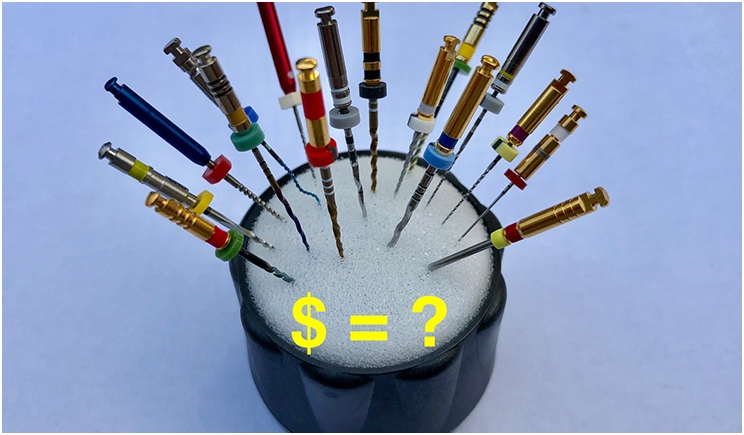
Do you really know the cost of your endodontic NiTi files? I bet most of you don’t. And I’m not only referring to the actual retail dollar cost of the instrument. This is how to determine the true cost of your files.
First: What Is the Actual File Cost?
If you’re like me, you may not know exactly how much every instrument costs in your office. For instance, do you know how much your gloves, resins, endo files, and other supplies really cost? You might be very surprised about what your files cost. Does each file you use cost $10 or $25? You should look into that. Furthermore, while this price per file is important, it is not the only thing to consider when calculating the real cost of your endo NiTi files.
Second: How Many Files Do You Use Per Case?
This is a very important point. Are you using a NiTi multi-file system that may, for instance, require five files for a routine case? Or is it a system that needs only one file to achieve the same outcome? There’s a clear trend toward systems that require fewer files to instrument a (routine) case. This has recently become possible thanks to the improved engineering and metallurgy of NiTi files. The fewer files needed, the cheaper your file cost may be per case.
Third: How Many Times Do You Need to Replace Your NiTi Files During a Case?
This is what I call real-world endo. An endo company might say its file systems only need a few files. Or, they may be fracture resistant or inexpensive. However, that might mean nothing if the files unwind easily and require many replacements per case.
A file that may be inexpensive but requires replacement during the endo is no longer that cheap. When you need to replace the file once or twice, its true cost doubles or triples, respectively. No longer is that file as cheap as you may have thought.
Furthermore, unwinding NiTi files that need replacement slow you down and, in turn, make the procedure take longer. When factoring in your overhead costs, this translates to increased costs per procedure.
In January 2017 I wrote an article about the issue of unwinding NiTi files and how significant it is. Quite simply, no matter how cheap or flexible or fracture-resistant a file may be, once it unwinds, it has failed and needs to be replaced. In turn, this makes the file system more expensive.
Fourth: How Time-Efficient Is the File You’re Using?
When it comes to office overhead, time is money. The longer you spend on a procedure, the more it costs you when considering your overhead. In turn, a single-file system is likely to instrument a (routine) endo case far faster than a multi-file system. That translates to saving money and increasing your profit per case. That’s the reality of running an office.
Summary
What your endodontic NiTi files really cost depends on a few factors. When combined, they give you the real-world cost of a file. The simple formula below sums it up:
TRUE COST OF YOUR FILES = cost per file x the number of files needed per system + the number of replacement files needed per case (ie if they unwind) + cost of office overhead
You might be very surprised how much your files really cost. Which do you think is more expensive: using files that are cheap individually but perform very poorly and unwind (or separate) easily and require, say, five files per case, or using a file that is more expensive but performs very well, doesn’t unwind or rarely fractures, and can do the same work as several files and do it faster? More often than not, it’s the latter.
For example, the total real cost of files per case can be caluculated as:
$10/file x 5 files (per case) + 2 replacement files (for unwound files) = $70
$25/file x 1 file (per case) = $25
So that file you thought was inexpensive might not be cheap after all. Especially if it is part of a multi-file system, it may unwind easily, require replacements, and take a lot of time to instrument a case. On the flipside, that expensive single file might not be as expensive as you thought if it performs well, doesn’t unwind, saves you treatment time and overhead costs, and can do the work of several files.
Hence, if expenses are important to you and the cost of your endo file or files per case is high, you should take a hard look at what you should use.
 Dr. Haas is a certified specialist with a full-time private practice limited to endodontics and microsurgery in Toronto. He is on staff at the University of Toronto Faculty of Dentistry and the Hospital for Sick Children. He lectures internationally and is one of Dentistry Today’s Leaders in Continuing Education. He is also a Fellow of the Royal College of Dentists of Canada. He can be reached via the website HaasEndoEducation.com.
Dr. Haas is a certified specialist with a full-time private practice limited to endodontics and microsurgery in Toronto. He is on staff at the University of Toronto Faculty of Dentistry and the Hospital for Sick Children. He lectures internationally and is one of Dentistry Today’s Leaders in Continuing Education. He is also a Fellow of the Royal College of Dentists of Canada. He can be reached via the website HaasEndoEducation.com.
Dr. Haas has no dicslosures to report.
Related Articles
Clinical Tips for Instrumenting Calcified Canals
Questions to Ask Prior to Root Canal Treatment
Managing Endodontic Emergencies











